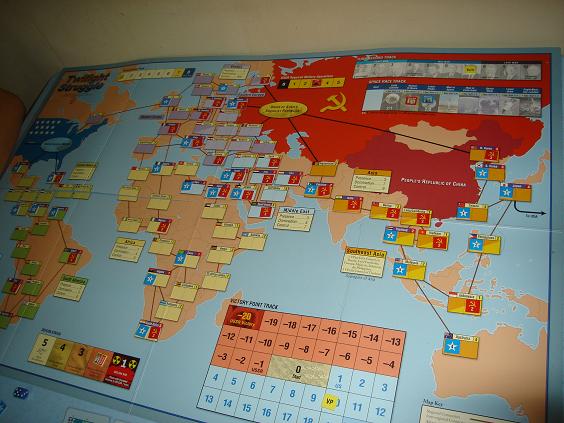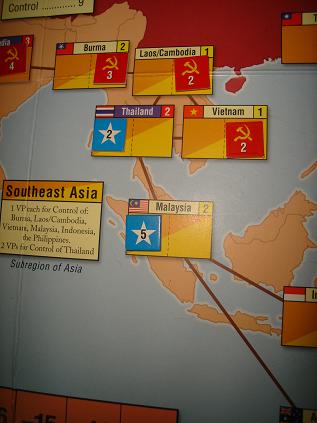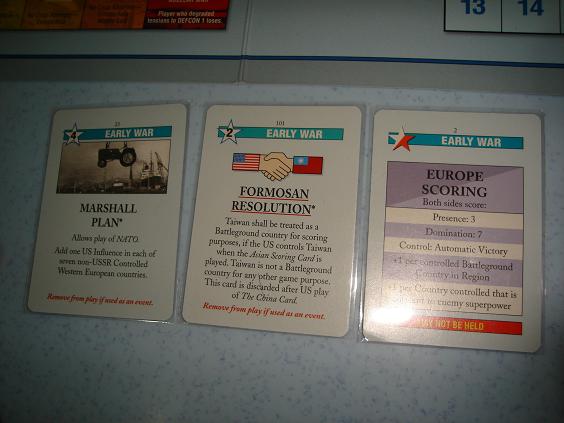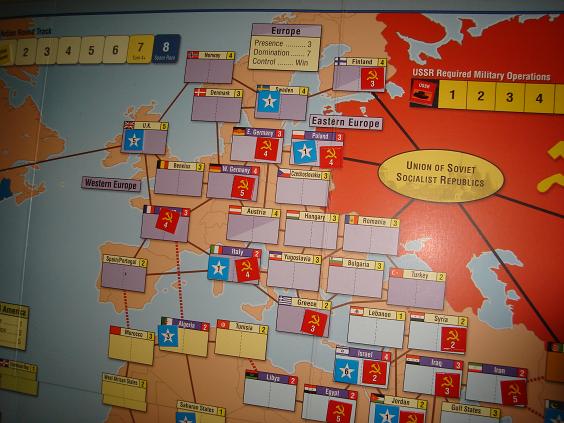
This one is yet another loaner from Han. Twilight Struggle is apparently considered an iconic wargame even though it doesn’t really have any fighting. Go figure. Joking aside it’s easy to see why it has such an iconic status. This is a two-player game designed to simulate the Cold War between the USA and the USSR and is played out on a stylized map of the world. While there obviously are unrealistic concessions to make it a better game, one has only to flip through the extensive historical background on the various cards in the game that’s included in the rulebook to see how seriously it takes its subject matter.
Since it’s such a well known game, I’m not going to go too much into its rules and I’m just going to write about some of my thoughts on it. The mechanics are really quite clever but there are so many little subsystems that it can be quite difficult for a new player to grasp all the different concepts and how they relate to each other. Add to that the sheer variety of cards and the size of playing field, and I think any new player will be quite confused about what he’s supposed to do.
For example, in our game, we used coups quite often but only bothered to use realignments towards the end of the game and it seemed to us that coups could be a surer thing and are worth more bang for our operations points. In some cases, they were so effective that I was wondering if we’ve gotten the rules wrong. We found it to be very easy to use coups to turn one or two points of the opponent’s influence in a low stability country to a huge four or five points of friendly influence.

Another thing that wasn’t immediately obvious when we first started out was that we had to basically play through our whole hand of cards each round, leaving only one card of our choice to hold over for the next round. Realizing that little fact sure made us appreciative of the Space Race as a safety valve to safely get rid of the opponent’s cards without their powerful abilities activating.
In our game with me as the USSR and my wife as the USA, my wife gained an early lead in the Space Race and I found it next to impossible to catch up after she gained the ability to play two cards towards that end. I managed to get a fairly solid footing in Eastern Europe with only Finland and Eastern Germany having any American influence, but I had a hard time early getting much influence elsewhere. I drew and passed on playing the USSR’s Cuba card as an event early and regretted it later as I had no way of getting any influence in Central and Southern America when my played the appropriate scoring card for the region.
The cards of course are central to the entire and I have mixed feelings about them. On the one hand, I have a fondness for card-based games as I’ve elaborated on before. The cards in Twilight Struggle are a particularly interesting in how they attempt to simulate historical events, resulting in a very wide variety of in-game effects. There are cards for moving up the Space Race track for free, cards for completely removing an opponent’s influence from the named countries, even cards that reduce the Operations Points your opponent gets for one round.
This is at the same time a sore point for me because while variety is good, the effects of the various cards are so specific and so powerful that playing the game without knowing beforehand what sort of cards exist is kind of pointless. I basically won my game because I drew a card that removed all US influence from a number of countries in Eastern Europe. Since my wife didn’t know that such a card existed, she was relying on maintaining a hold over some of the battleground countries there to prevent me from controlling the whole continent which results in an instant victory when the Europe scoring card is played.
This can be mitigated somewhat if you have a working knowledge of the geopolitics of the era, so if you’re the Soviets you should know better than to invest your resources in trying to gain control of Japan and so forth. But knowing the cards is still so important that I think it would only be fair to have new players read through all of the cards first even though I generally prefer to have players discover the contents of a game through repeated plays.
Once again, my experience of the game is too limited to really say too much but I suspect that a lot of the game would involve each player watching and waiting for the opponent’s specific cards to be played and discarded. I also note that the edition of the game Han has is unbalanced in favor of the USSR but this imbalance has since been redressed in the recently released deluxe version of the game. For example, one particular card, Aldrich Ames, made me go, “Wait, this can’t be real, can it?” when I saw it but it seems that the newer edition includes a less powerful version of the same card.
I have to say that I really enjoyed the game overall and it strikes me as the kind of idea that I never would be able to come up with in a million years. I can even see it as a useful teaching tool. I have doubts about it’s long-term longevity as a game once both players become intimately familiar with the cards and I can easily see luck having a significant impact due to the card draws. This means that it’s not really a game about long-term planning as the whole map could change drastically at any time but instead one about managing risks and potential rewards in the short-term. Still, that is kind of what the Cold War was all about, wasn’t it?


Leave a Reply